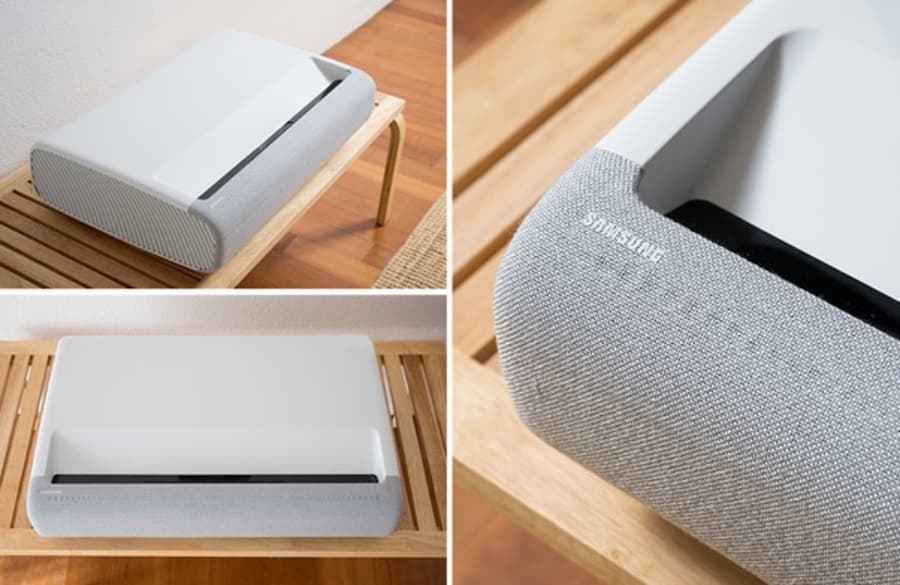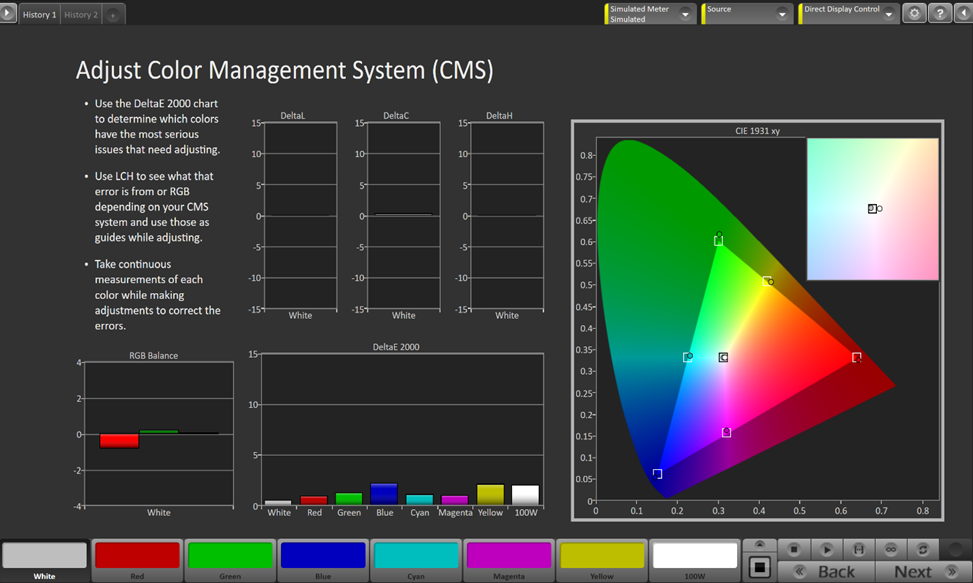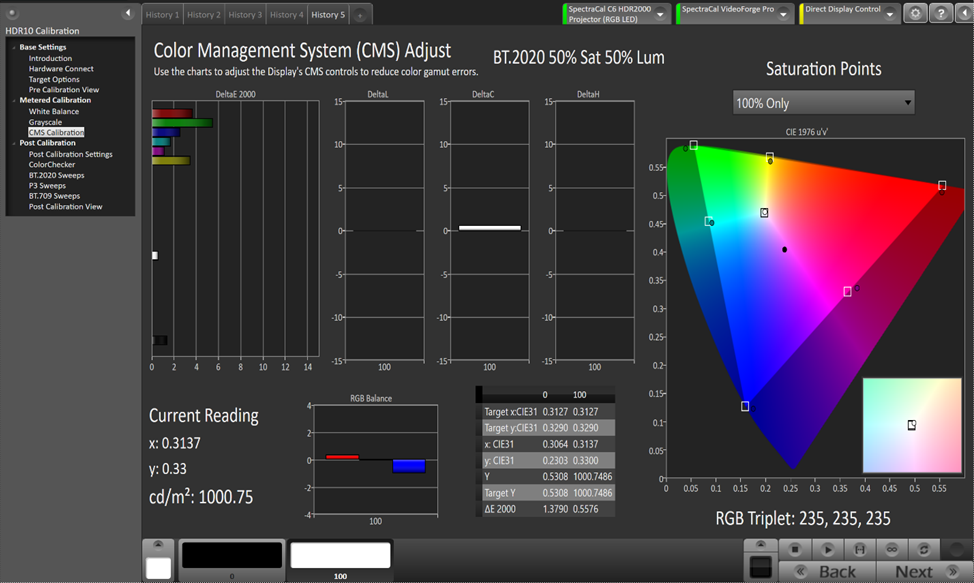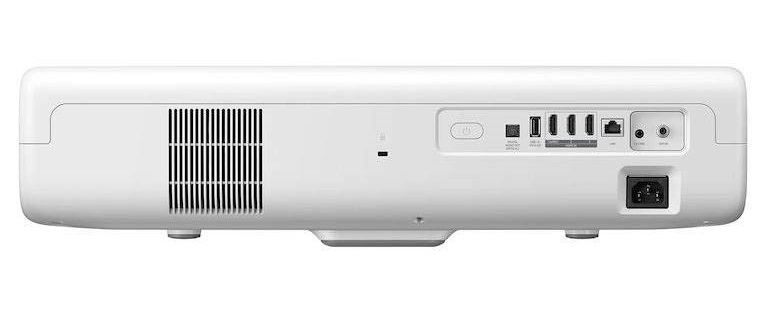Highlights For The Samsung LSP9T
The Premiere LSP9T 4K Smart Triple Laser Projector with a projected image in the 100” to 130" Range Class of Ultra Short Throw projectors. Enjoy theater-like entertainment in your home with the best Samsung ultra-short throw smart laser projector. Cutting-edge triple laser technology and ultra-bright 4K resolution deliver heightened contrast and impeccable detail with 2800 lumens of light output.
- 4K UHD Ultra Bright Laser
- True Discrete RGB Laser Light Source
- No Need for a Color Wheel or Lamp Changes
- Full BT.2020, DCI-P3 & BT709 Color Gamut Coverages
- Smart TV Powered by TIZEN™
- Ultra-short Throw and Compact Minimal Design
- Powerful 40W 4.2 Channel Acoustic Beam Audio System
- Multiple Voice Assistants (Bixby, Alexa, Google Voice)
- 2800 ANSI Lumens Brightness
- 20,000 Hour Light Source Life
- Digital Keystone Correction
- HDR10, HDR10+ & HLG High Dynamic Range Compatibility
- ATSC & Clear QAM TV Tuner
PROS
- True RGB Lasers for full 106% of BT.2020 Color Gamut
- Great Inter-Image ANSI Contrast
- Sharp, Detailed Image
- Bright 2,800 ANSI Lumens to overcome ambient light
- Great & Familiar Samsung Tizen Smart TV OS, Just Like Their TV's
- Limited Color Separation Artifacts (*Rainbow Effect)
- Nice sounding built in 4.2 channel sound system
- Built in TV Tuner
CONS
- Vibrant but oversaturated colors in most modes
- Hard to calibrate exactly to spec
- Not great sequential on/off contrast, typical for DLP, but better than its competitors
- Some chromatic aberration (red, green & blue alignment) from lens on some units
Whitish-Green bright spot at lower middle section of screen. (Can be minimized with optimal installation)
- Higher cost than similar models
- Too minimalistic remote causing too many button presses to get to needed options
Aesthetics

Lifestyle Design. Beautiful from every angle with a premium fabric finish, The Premiere is the perfect blend of minimalist design and superior engineering.
As seems to be the current trend with many of these UST projectors, the housing of the unit is only available in white. I understand that Samsung and other manufacturers opt for the white housing for a more modern aesthetic, but I would personally prefer a black housing option to match the other components on or in the credenza.
It features rounded corners and an attractive fabric cover for the speakers on the front of the unit. The projector’s lens is recessed beneath the top of the projector as are most other home theater USTs.
On the bottom of the projector, there are 2 adjustable feet in the front which will allow you to physically fine tune alignment with your screen.
Installation, throw ratio, zoom
Throw Ratio: 0.189:1
This throw ratio gives the Samsung LSP9T the ability to sit closer than just about any other projector. To make a 100” screen size it only needs to be placed 4.4 inches from the screen and just 7.7 inches to create a 120” image on the screen.
Choose your size to view your placement guide:
Projector to Screen Alignment
Overall we found aligning the projector and screen to be more difficult than other other laser TVs. This is because the Samsung LSP9T only has 2 adjustable feet, instead of the 4 feet you'd find on the Hisense L9G. this made it slightly more difficult to fine tune the alignment.
The more challenging part of alignment was that you can't adjust the feet without lifting the projector, so any time you adjusted the height of the feet you had to realign the projector.
The screen alignment menu option however, did make it easier to align the projector and screen.
Projector Focusing
There is an electronically adjustable focus mechanism built into the LSP9T, so it is very easy to adjust focus based on your screen size between 100-130”. Though we’re not crazy about the focus screen Samsung gives you.
 Some USTs do not feature this, so you must pair it with the sized screen it is designed to throw onto and the focus is optimized for this size only.
Some USTs do not feature this, so you must pair it with the sized screen it is designed to throw onto and the focus is optimized for this size only.
Lens Zoom
N/A. USTs are fixed zoom and rely on physically moving the projector forward and backwards to make their images smaller and larger.
Geometric Correction/Warping/H & V Keystone

The LSP9T has two geometric correction options to choose from. There is a 4-point correction which allows you to adjust the corners of the screen, or choose the more advanced 15 point correction for a more granular control of the correction points across various areas of the screen.
There is no horizontal or vertical keystone with UST projectors. To set up and correct distortions, all settings are done manually by physically realigning the placement of the projector and adjusting the feet, in relation to the screen surface.
Projector Light Source
The LSP9T features a 20,000+ hour life to half brightness, which is dependent on the laser power and modes used throughout its lifetime.
The Samsung Premiere LSP9T UST is an RGB Tri-laser projector, which means it features true, dedicated Red, Green and Blue laser diodes as its light source. This can produce greater than BT.2020 colors (~107%) on screen. This UST projector is based on the same chassis as its sister unit, the LSP7T, but instead of blue laser phosphor which uses an inferior color and phosphor wheel to create its colors, it uses RGB laser diodes for much greater color performance and depth, able to create a much more lifelike image on screen with colors that match reality closer than anything we have experienced before in your home, and even the theater for that matter!
Brightness
With ambient light from light fixtures and windows, as in a typical living room environment:
The LSP9T has the power and oomph to punch through normal ambient lighting conditions with brightness to spare. I tested it on both an ALR screen and a plain white acoustically transparent white screen and in both instances the image was more than watchable and still discernible as far as colors and image fidelity. The UST ALR screen is by far the best choice, as expected in this situation.
For testing we used the Spectra Projection Vantage UST screen.
With lights off, in a dedicated and light controlled environment:
Of course when you turn off the lights and control ambient light, the projected image takes on a whole new dimension of colors and depth of image. This UST is one of the best if not the best UST available with its triple laser light source and amazing BT.2020 colors! When compared to other projection technologies I have experienced over the many years of my experience, the LSP9T is utterly jaw dropping when you see the colors it reproduces for the first time and even in subsequent viewings. The added color volume enhances the perceived brightness due to the Helmholtz-Kohlrausch (HK) Effect. It also helps perceived contrast to some degree, enhancing the already superb inter-image contrast, resulting in a deep, sharp, detailed 3-dimensional image. The standard white screen is your best choice if you plan to install the LSP9T in a light controlled environment.
Measurements in all modes, rated at 2,800 Peak Lumens
Mode |
Lumens |
Game |
2,592 |
Dynamic |
2,834 |
Standard |
2,486 |
Movie |
2,349 |
Filmmaker |
2,065 |
Color Gamuts
The Samsung LSP9T offers bright and vibrant colors.
This UST projector covers around 147% of the DCI-P3 color spectrum and around 106% of BT.2020 and will have you future proofed as content taking advantage of that wide color gamut becomes increasingly more available. This is the first projector that is HDR10+ certified and will provide a superior high dynamic range experience.
SDR Color Gamut
The Rec.709 color gamut was easily attained on the LSP9T, with just the green being slightly elevated at the highest 100% point. Out of the box all modes except Movie and Filmmaker totally oversaturate the colors to their full BT.2020 levels, resulting in a lot of oversaturation in the image, with colors looking too cartoony and unnatural. Using Movie or Filmmaker as a baseline to begin your calibration is the best way to tame this oversaturation easily.

HDR Color Gamut
The HDR Color Gamut is much the same out of the box as the SDR. It is somewhat oversaturated and out of phase. This isn’t as much of a problem as SDR because it is wider and closer to BT.2020 to begin with. The Red, Magenta and Green were however out of phase, leaning too much towards their adjacent colors before a good calibration. White was skewed towards blue. The saturation sweeps (points between D65 White and 100%) didn’t track as well as other, newer RGB Laser USTs we have since tested, but this is near impossible to see in real life images on screen.

Contrast
The specifications of this laser TV detail a 2,000,000:1 dynamic contrast ratio which utilizes the projector’s Dynamic Black for a perceived contrast far superior to its lower priced UST alternatives.
Native/Sequential/On-Off:
- Off screen (.8 gain AT): 1957:1
- Direct w/ diffuser: 2243:1
ANSI/Inter-image:
- Off screen (.8 gain AT): 458:1
- Direct w/ diffuser: 2303:1
This is one of the best contrast ratios we measured compared to most other laser TVs.
Sharpness
Sharpness in displays is usually a rudimentary edge enhancement processing feature which, if not done well, can result in severe edge outlining, especially on straight lines and the outlines of objects in the image. This is known as “ringing” or “haloing”, as can be seen in the below examples. Very few manufacturers and displays do sharpness in a helpful way which makes the image appear to have more detail or sharper lines without distortion. A good example of doing right would be DarbeeVision, which if used judiciously makes the image appear more detailed, 3-dimensional and with more contrast without causing white lines around objects. Sony’s Reality Creation is that and so much more.
 Dynamic Mode with maximum sharpness set, causing excessive white ringing/haloing around the black lines
Dynamic Mode with maximum sharpness set, causing excessive white ringing/haloing around the black lines
 Filmmaker Mode with minimum sharpness settings. Reduces the ringing a good deal, but it’s still present.
Filmmaker Mode with minimum sharpness settings. Reduces the ringing a good deal, but it’s still present.
 Close up of ringing/haloing due to excessive sharpness control settings
Close up of ringing/haloing due to excessive sharpness control settings
Motion Handling
Motion is quite good on the LSP9T, despite that when it receives a 24p (23.975Hz) it converts it to 60p (59.94Hz). Sometimes poor motion handling by the display can result in what is known as “The Soap Opera Effect” (SOE). This is not the case here. Samsung employs good telecine processing, but it would of course be better if it could take native 24p from film sources and process it to 48 or 72Hz, doubling or tripling the rate evenly to avoid poor motion and dropped frames.
Imaging Technology/Chipset
The LSP9T uses a 2716 x 1528 pixel 0.67" DMD chip from Texas Instruments and uses XPR technology, which diagonally shifts the image ½ pixel vertically and ½ pixel horizontally. It does this at 120Hz for the process to go from 4 million pixels to an individually addressed and perceived 8 million pixels at the UHD resolution of 3840 x 2160. Many say this is technically not true native 4K UHD resolution, but the resulting image is nearly imperceptible from native 4K displays. The only true way to tell is looking at 1 pixel test patterns, but in real life this is essentially moot as far as real perceived image detail.
Using this chip is said to increase perceived resolution over the smaller 0.47” 1920 x 1080 chips, as well as better native contrast due to the larger chip size and pixel pitch.
Gaming input Lag
The LSP9T features a Game mode which disables the projector's processing as much as possible to provide dedicated low-latency for those gamers among us, which I am not. If you are a gamer though, even in Game mode the input lag may still be considered to be high at around 55ms. This shouldn't bother more casual gamers like most folks who do it for fun and to kill time, but first-person shooter pros will find it way too unresponsive to be competitive with. The excellent motion handling mentioned previously does help make the Game mode work well for most of us.
Built-In Sound System
The LSP9T has a powerful 40W, 4.2 Channel Acoustic Beam Audio System built in. They market it as ATMOS capable, which technically without speakers all around and above you is not possible, but this system does a surprisingly good job of simulating the ATMOS effect. If you are sitting in the center sweet spot, the phantom sounds coming from all around you and the center dialog do a convincing job here.
The Acoustic Beam sound system’s equipment consists of two tweeters and mid-woofers along with twenty two small tuned ports on the top front left and right sides. These send the sounds up towards your ceiling and out to the side walls, giving you the ATMOS Surround effect mentioned earlier and creates quite the convincing soundstage for a projector.

Remote Control
The remote is the same minimalist one used with many recent Samsung TVs. It has Power on/off, the Google Voice button for searches, Home, Play/Pause, Mute, Volume and Channel up/down rocker style buttons, Numbers button which brings up an on-screen number selection menu, Back arrow, direction ring/arrows and a round center OK/Select to choose what’s highlighted on screen.
The minimalist remote makes it a tad cumbersome to get to any selection and makes calibrating a pain, with multiple button presses and menus to get through just to get to the picture menu. I ended up using one of my leftover Samsung Remotes from an old, trashed plasma HDTV, which has a dedicated picture menu button. This definitely helped alleviate some of the pain.
That said, the modern design will make those that care about such things happy and it will look nice on your coffee table or credenza.
User Interface and Menu System
The User Interface and Menus are consistent with other Samsung displays, so those that have experience with them should feel comfortable here.
It was very easy to navigate through the options and make changes.
Connectivity Ports

The LSP9T has three HDMI inputs, one of which supports eARC. We're definitely big fans of when projectors offer at least 3 HDMI ports.
There’s also an optical audio out, a USB 5V port, ethernet network jack, F-Type coaxial cable input and Ex-Link Samsung service port.
Picture Modes
Dynamic Mode:
- Best for bright environments such as board rooms, rooms with many windows or light fixtures. Graphic presentations to highlight colorful charts, Slideshows, etc.
- It boosts up the peak brightness and over saturates the colors to make them “pop” in bright rooms.
- Looks overly bright and peaked with vibrant, unnatural colors.
Standard Mode:
- Best for rooms with some subtle ambient light, such as sconces on dimmers, but nothing too overpowering that would wash out the screen. Good for sports and TV watching, where you may want some ambient light to multitask or to interact with other people.
- This mode basically just boosts up the blue to give a more cool looking presentation that is more pleasing to the eye, and also helps overcome the small amount of ambient light. Black levels may be slightly elevated as well.
- Looks similar to the Film or Cinema type modes, but with a cooler, more blue image along with higher brightness, to help alleviate the effects of room lighting. It has a more natural tone to it than Dynamic Mode.
Movie Mode:
- This mode is for those who like the standard mode, but are watching in a more light controlled or blacked out room. Maybe the same environment, but in the evening with the lights off.
- It tones down the brightness and comes closer to D65 white point. Colors get closer to ideal and natural.
- It still has the cooler (more blue) image, but not as bright and closer to the standard D65 white point than Standard Mode.
Filmmaker Mode:
- This is the mode for the serious home theater enthusiast who watches in a dedicated, light controlled blacked out room and wants the image to be rendered as close to the film maker’s intent as the manufacturer allows.
- This mode defeats all processing (or at least it should!) in the projector and is supposed to be calibrated to the closest color gamut to standard, without being overly bright or clipping in either the high or low ends of the spectrum.
- This mode looks more “celluloid and film-like”, to some seeming flatter and less dynamic in its default settings. Colors are more muted than other modes, but in reality are closer to the standards, which most are not used to being exposed to, and many don’t prefer to be honest.
Game Mode:
- As the name implies, it is for the gamers of the crowd who are seeking the lowest lag possible to compete with other serious gamers, namely first person shooter type games.
- This mode defeats nearly all processing in the projector and provides the clearest path to the imaging chip to allow for the fastest image rendering and display time from game controller to screen. It also allows for the projector and game console to activate its HGiG (HDR Gaming Interest Group) mode.
- Game Mode looks like a cross between Standard mode in its appearance and Filmmaker mode in how it defeats most/all processing “features”. It has a more cool appearance unless manually calibrated or changed.
My favorite picture mode on the LSP9T is Game Mode, which must be set in a separate menu. If you calibrate in this mode, which has most of the “special features” defeated, the image takes on a very clean, sharp and detailed look, especially for HDR. Other modes just seem to be more harsh and digital looking in comparison.
SDR (Standard Dynamic Range)
Out of the Box
The out of the box SDR experience is about the same as HDR on the LSP9T, with its overblown colors and too-blue images and boosted mid-tones with a slight magenta cast although being quite pleasing yet inaccurate. The 100% Color Saturation points are way out near the full BT.2020 gamut points, rather than down near the Rec.709 points where they belong. The lower points of the saturation sweeps are closer, giving the image a less totally oversaturated look, but it definitely was in need of a good calibration.

After Calibration
Once calibrated, the color gamut and greyscale fall into line, as with HDR. It has a slight inaccuracy in the green at its peak, but the sweeps track fairly well. The greyscale is flat where it should be across the range. The gamma is spot on throughout the range, resulting in perfectly rendered and spec’d images, and it shows in real world watching. I flattened it out via the 10 point white balance and it made the end result very impressive!

HDR (High Dynamic Range)
 Before calibration
Before calibration
 After calibration
After calibration
Out of the box
HDR on the LSP9T at first glance out of the box is pure eye candy, even with its overblown colors and too-blue images, along with the boosted mid-tones. It also had a slight magenta cast to it, due to the extreme red laser in this model. Even so, the image is quite pleasing and you wouldn’t know it was so inaccurate.

After Calibration
Once calibrated, the image becomes even more pleasing, and accurate too! The greyscale falls into line nicely with just slight bumps and inaccuracies in the midranges where the tone mapping is kicking in. Otherwise it is flat where it should be in the lower and upper ranges. The EOTF (HDR “gamma”) is slightly raised throughout the range, resulting in brighter than spec’d images, but in real world watching this doesn’t seem to be the case and it I believe actually improves the overall image, giving it more punch as they say, although inaccurate. When I flattened it out via the 10 point white balance, it made the images appear too flat and lifeless, without that HDR look and feel we all know and love. I am sure with more time I could get it near perfect in measurement and look.

To Sum It Up
The Samsung Premiere LSP9T is absolutely one of the best 4K UST projectors available right now in just about every regard. That being said, it is also priced accordingly at $6,500. That is almost 2x more expensive than the other UST in the Samsung Premiere line, the LSP7T.
While this projector may be out of reach for those with more limited means or those who are more interested in getting the best value for their dollar; this is a top contender for anyone who is interested in getting the “Best” ultra short throw projector.
In order to get the best performance out of this projector in a moderate to well lit environment, we strongly suggest pairing it with a legitimate 4k+ UST ALR screen such as the Spectra Vantage, Stewart Balon UST, SI Short Throw or Elite Screens DarkStar UST (not their CLR) surface.
Specs
Projector Resolution: | 4K |
Brand: | Samsung |
Product Status: | Leaves Warehouse within 4-6 Weeks |
Lumens: | 2800 |
Projector Type: | Ultra Short Throw |
Light Source: | Laser |
Contrast Ratio: | 1,500:1 |
Chipset: | DLP |
Aspect Ratio: | 16:9 [HD] |
Throw Ratio: | 0.19:1 (D:W) |
Native Resolution: | 3840x2160 |
Lens Shift: | No |
Input Lag: | 4K/60Hz: 55.9ms | 1080p/60Hz: 55.9ms |
3D Support: | No |
Warranty: | 1 Year |
Standard Lens Focus: | Motorized |
Wi-Fi: | Yes |
ARC/eARC: | eARC |
Operating System: | Tizen |